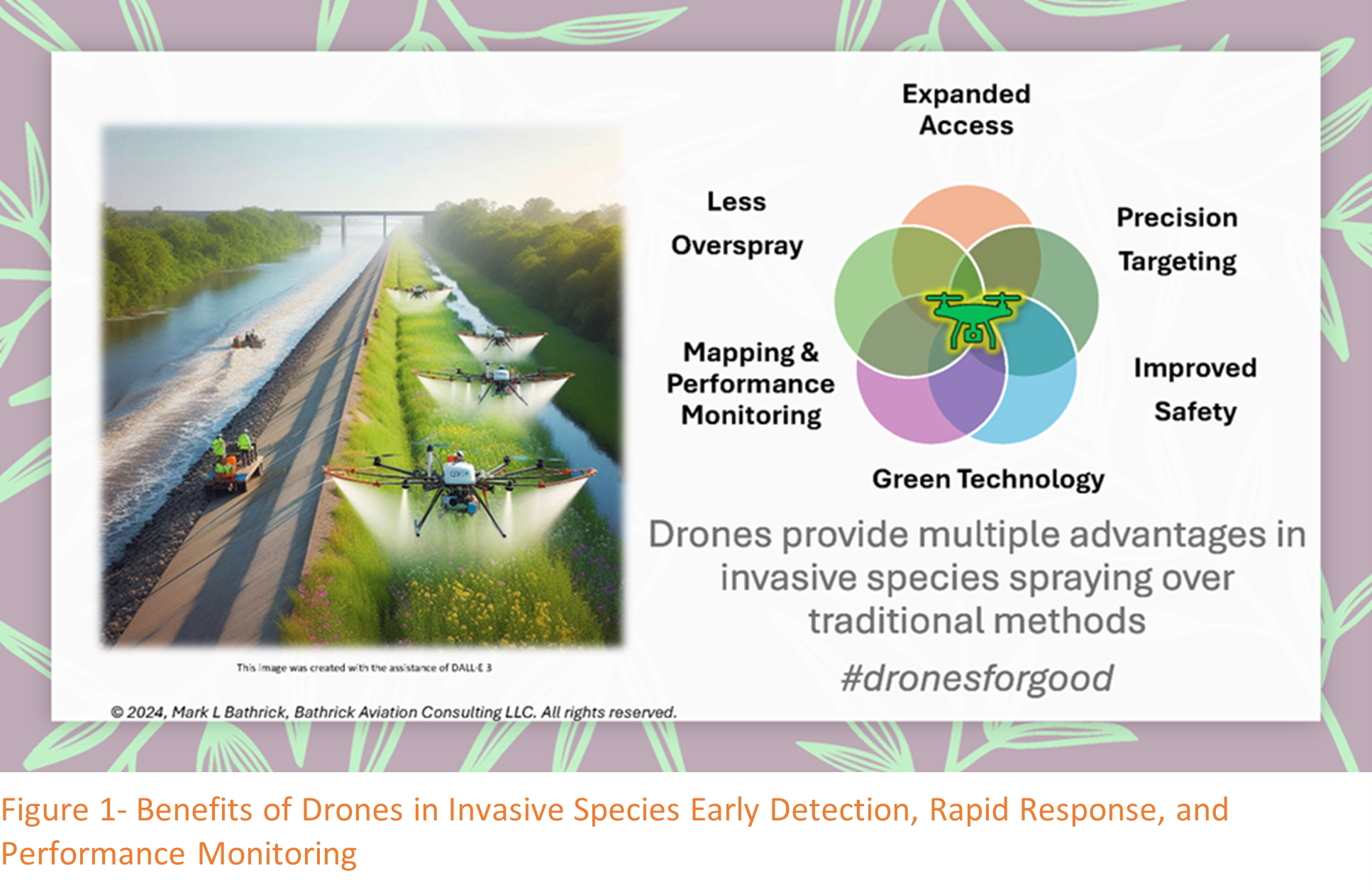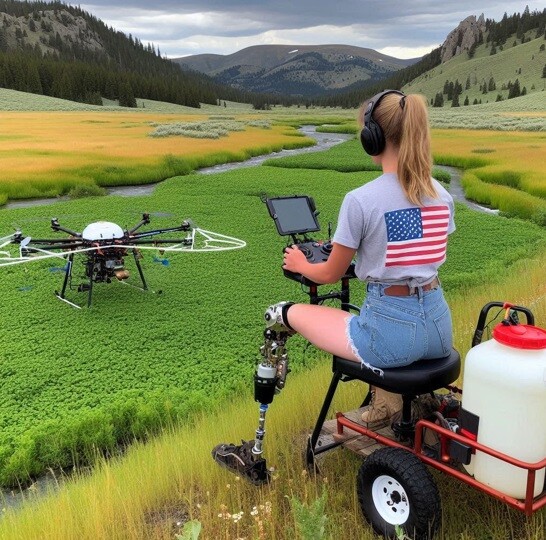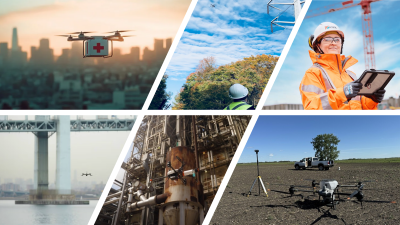The enemy is relentless. They have infiltrated all 50 States and are adept at hiding among the natives. They also seek out places that are hard to reach, often flourishing in conditions and environments that challenge the natives. While climate change has tested the resiliency of the natives, it has expanded the territories within the enemy’s reach.
The enemy is destructive invasive species of plants and animals, and experts are now turning to new technologies, including drone systems, to fight back
The Current Battle Status and Cost of this War
The damage this enemy continues to inflict is great and extensive, and the need to adopt effective new approaches to battle these species grows every day. According to the U.S. Department of Agriculture’s National Invasive Species Information Center, a 2021 study estimated invasions of non-native plant and animal species have cost the North American economy at least $1.26 trillion between 1960 and 2017.[i] Those costs have steadily climbed from $2B per year in the early 1960s to over $26B per year in the 2010s. Another study estimated that the approximately 50,000 nonindigenous species in the U.S. result in environmental damage and losses totaling $137B annually.[ii]
Invasive species impact the American consumer through increased food prices due to reduced yields and higher production costs, higher water and energy prices from invasives impacted infrastructure that often require extensive maintenance and repair, as well as impacts to health, property values, and recreational activities.[iii]
Destructive invasive species have also contributed to increasing occurrences and devastation from natural phenomena like wildfires. Chief among these invasive species is cheatgrass, which was accidently introduced to the U.S. in the mid-to-late 1800’s, likely as a contaminant in crop seeds and straw.[iv]
According to the National Invasive Species Council, 1.3M acres of sagebrush have been lost to invasive species such as cheatgrass.[v] Cheatgrass has several characteristics that have had a significant impact on wildfire frequency, size, and spread. Cheatgrass dries out faster than native vegetation, lengthening the fire season. Its fine leaves and stems ignite easily and burn hot, resulting in more frequent ignitions, faster spread, and more intense wildfires.
Finally, its compatibility with post-fire soil compositions and rapid growth rate enables it to quickly invade empty spaces created by the fire and reduce the fire recurrence interval from 20-100 years to 3-5 years.[vi] A 2023 report by the Congressional Research Service indicated there was a 20 year backlog in hazardous fuels treatment needs.[vii] Fast growing invasives such as cheatgrass make it increasingly challenging for agencies to make a dent in this growing backlog, further increasing the risk for more frequent and intense wildfires and the costs to combat them, which the U.S. Forest Service predicts will rise by about 42% to $3.9B per year by 2050.[viii] Similarly, in 2021, the U.S. Department of the Interior reported that less than one percent of acres infested by invasive plant populations were currently under control.[ix]
Like wildfires, invasive species don’t respect state lines nor organizational jurisdictions. Recognizing this as a national issue, the Federal Government has been engaged in combating invasive species since the Lacey Act of 1900.[x] More recently, Executive Order (EO) 13112 of Feb 3, 1999, which created the National Invasive Species Council and EO 13751 of December 5, 2016, have promoted the increasing use of technology in addressing this silent, yet costly and unrelenting adversary. In 2016, it was estimated the Federal Government spent $2.3B across a range of agencies and activities to combat invasive species.[xi]
Most recently, the Dingell Act of 2019 and the 2021 Bipartisan Infrastructure Law each included over $100M for invasive species prevention, early detection, and eradication.[xii] [xiii] While the annual federal, state, local, tribal, and territorial government spend on combatting invasive species is not explicitly recorded, it’s estimated that across DOI and USDA, spending on invasive species management could range from $300M to $400M annually.
Current Invasive Species Strategies
The U.S. employs several prioritized strategies in its efforts to manage invasive species:
1. Prevention: This involves stopping invasive species from entering the country, often through stringent regulations on international trade and travel and public education. While this is the most effective way to manage invasive species, global trade, increasing populations, and easier travel between and within nations makes prevention of invasive species entry increasingly difficult.
2. Early Detection and Rapid Response (EDRR): Quickly identifying and responding to new invasions or the spread of current ones to previously unaffected areas can be highly effective, when monitoring and surveillance programs can rapidly detect new or expanding invasions. EDRR has increasingly become the approach of choice among many agencies.
3. Control and Management: When an invasive species is too well established to be completely eradicated, control measures (e.g., mechanical removal, chemical treatments, introduction of natural predators or diseases) can serve to mitigate the impact in targeted areas of concern.
4. Rehabilitation and Restoration: In areas where invasive species have successfully been eradicated or controlled, rehabilitating damaged landscapes and restoring native species can prevent a future resurgence of invasives.
The Promise of Drone Technology
Despite the growing challenges and costs associated with invasive species, there is new tech that holds the promise of achieving “better, faster, cheaper, and safer” results—drones. The widespread application of “Drones for Good” can trace its roots to 2006, when the U.S. Department of the Interior (DOI) initiated a program to apply drone technology in support of its responsibilities in managing over 500M acres of public lands.[xiv] While there had been earlier examinations of drones in non-military/intelligence missions, the DOI program was the first comprehensive effort to incorporate drones across a wide range of science, natural resources, and public safety missions and to develop and capture performance outcome metrics.
Building on DOI’s example and success, other sectors have realized the Science, Safety, Savings, Service, Sustainability, and STEM values of “Drones for Good.”[xv] One of those is agriculture. Drone use in agriculture is part of the larger trend toward precision farming, supported by automation, improved data collection and analytics, and other technologies.
Drones have demonstrated the ability to dispense products five times faster than traditional equipment. When incorporated with drone-based crop monitoring, they’ve also been shown to reduce the amount of product required by 60% through targeted treatments, supported by drone-based monitoring that provides higher resolution data than traditional satellite methods and faster detection of crop stress, disease, and infestations.[xvi] With returns on investment (ROIs) like this, it’s no wonder that the U.S. agriculture drone market is expected to grow at a compound annual growth rate (CAGR) of nearly 23% through 2030.[xvii]
The same drone attributes that continue to benefit farming and agriculture offer great promise for being a gamechanger in invasive species early detection and rapid response (EDRR). As shown in Figure 1, Benefits of Drones in Invasive Species EDRR include:
1. Expanded access: Drones can access areas that are difficult or impossible for traditional ground-based equipment to reach. Hilly or uneven terrain, marshy areas, and areas with limited infrastructure can all pose challenges to ground-based sprayers. Drones can also operate in areas that are too wet for heavy machinery, reducing delays after rain and enabling timely application of pesticides.
2. Less Overspray: Drones allow for more precise control over spray application compared to traditional methods. The sprayers can be calibrated to accurately deliver only the necessary amount of chemicals, minimizing overspray when large equipment covers broad areas. Accurate altitude control and targeted spraying ensure that chemicals are applied only where needed, with minimal waste. By reducing overspray, drones help in:
- Preventing damage to non-targeted plants
- Minimizing environmental impact, including the runoff of pesticides into nearby water sources
- Reducing the amount of chemicals needed leads to cost savings and more sustainable practices.
3. Mapping & Performance Monitoring: Modern drones are equipped with sensors, Real Time Kinematics (RTK), and imaging technologies that allow them to collect valuable data during their flight. The data is then transferred to spray drones for accurate application (spot spraying). Drone data can be used to make informed decisions about future applications, assess the effectiveness of previous treatments, and adjust practices as needed. This results in optimized inputs, less waste, and improved spot spraying. In addition, long-term monitoring allows for predictive analysis and anticipation of problems before they become widespread. This data includes:
- Plant health/evasive species analysis using multispectral or imaging
- Soil moisture levels
- Pest infestation patterns
4. Precision Targeting: Drones excel in precision targeting, which allows for applying chemicals to specific areas rather than blanket-spraying entire areas. This capability is handy in spot-treating weed infestations. Only targeting specific areas minimizes chemical usage, reduces costs, and improves the overall operation. The precision is far superior to traditional methods, which often indiscriminately cover a much larger area. A 2021 study also found that drone-based sprayers produce smaller droplets than traditional backpack spray rigs and that the rotor downwash field can force droplets deeper into the plant canopy, potentially reaching the undersides of leaves for more effective coverage while requiring less product.[xviii]
5. Improved Safety. The use of drones significantly improves worker safety. Traditional methods of spraying often require human operators to work near hazardous chemicals. Drones reduce the need for human exposure to these chemicals by hot loading and allowing for remote operation from a safe distance.
6. Green Technology. An added benefit is battery-powered drones produce zero
emissions, significantly reducing the carbon footprint of aerial applications compared to fuel-based alternatives.

Expanded Technology Job Opportunities for New Warriors
While the ongoing national battle to manage invasive species stands to reap huge benefits from the incorporation of drones for early detection, rapid response, and post-treatment outcome monitoring, drones also present new technology job opportunities for millions of deserving wounded warriors. Just as the cost and complexities of using traditional crewed aircraft formed barriers to their widespread use in the war on invasive species, similar barriers have prevented many wounded warriors from becoming pilots of crewed aircraft.
Drones have “democratized the 3rd dimension,”enabling everyday people to easily become certified commercial drone operators. But also, because of their advanced technologies that promote simple and safe operations, drones have opened piloting opportunities to constituencies for which piloting a crewed aircraft is not an option. This is particularly true for the historically under employed disabled veteran community. Drones and the FAA’s thoughtful approach to risk-based rule making have enabled wounded warriors and other Americans with similar disabilities the opportunity to pursue employment as drone pilots.[xix] [xx] [xxi] [xxii] Similar programs have been established to assist injured on duty public safety/first responders that are otherwise unable to return to active duty to continue serving their agencies and communities as drone pilots.[xxiii]
The federal government has also recognized the opportunity for drones to provide meaningful new technology careers to millions of Americans with disabilities in areas like invasive species EDRR. In March 2023, SourceAmerica, operating under the AbilityOne Program announced a groundbreaking new Mentor-Protégé Program (MPP) that aims to foster collaborative partnerships between large businesses and non-profits, with the goal of employing individuals with disabilities in nontraditional fields (like drone services) in support of government contracts.[xxiv] The MPP also affords powerful benefits to participants including bidding on federal contracts with limited competition and the ability to support a contract for 10 years or more without recompetition.[xxv]
In a demonstration of its support for expanding the employment opportunities for veterans through this program, the AbilityOne Commission issued updated policy on January 1, 2024 that establishes the eligibility for veterans as any individual receiving benefits under the Veteran’s Administration (VA) disability compensation system.[xxvi] This eligibility starts at a minimum VA disability rating of 10%.[xxvii] As of 2023, there were approximately 17.8 million veterans in the U.S. Of these, around 5.2 million veterans (or about 30%) have a service-connected disability rating of 10% or higher.[xxviii]
In April 2024, PORTCO, Inc, an AbilityOne Program nonprofit agency and Farm-i-tude, an agriculture focused drone application services company entered into the first of its kind Mentor-Protégé Agreement (MPA). Under the MPA, the Portco-Farm-i-tude Team will provide the federal government with cutting-edge drone-based application and monitoring services while providing meaningful new job opportunities to wounded warriors and other deserving Americans with disabilities.[xxix]
A Call to Action to Leverage New Tech and New Warriors in this Battle
Invasive species are an insidious and relentless enemy that pose a severe threat, spreading across states and thriving in challenging environments. Invasive species have cost North America over $1.26 trillion from 1960 to 2017. Their impact includes increased food prices, infrastructure damage, and heightened wildfire risks, notably from cheatgrass. Federal spending on efforts to manage them is estimated at $300M-$400M annually.
Drones offer a promising new tool in the early detection and rapid response to invasives, providing expanded access, precise application of treatments, detailed mapping, and improved safety. Their growing use in agriculture demonstrates their efficiency and reduced environmental impact.
SourceAmerica’s groundbreaking Mentor-Protégé Program has created new job opportunities for veterans and other Americans with disabilities in technology careers like drone services. For federal agencies, it expands the capabilities of the AbilityOne Program by matching qualified organizations with high-priority lines of business like invasive species management. And for Mentor-Protégé Teams, it can mean sole-source, not subject to Government Accountability Office (GAO) protest, no-recompete federal contracts as long as the mission requirement exists.
Now is the time to combine the power and versatility of drones with the advantages and opportunities of SourceAmerica’s Mentor-Protégé Program to apply new weapons and enlist new warriors in the fight against invasive species in the U.S
















Comments